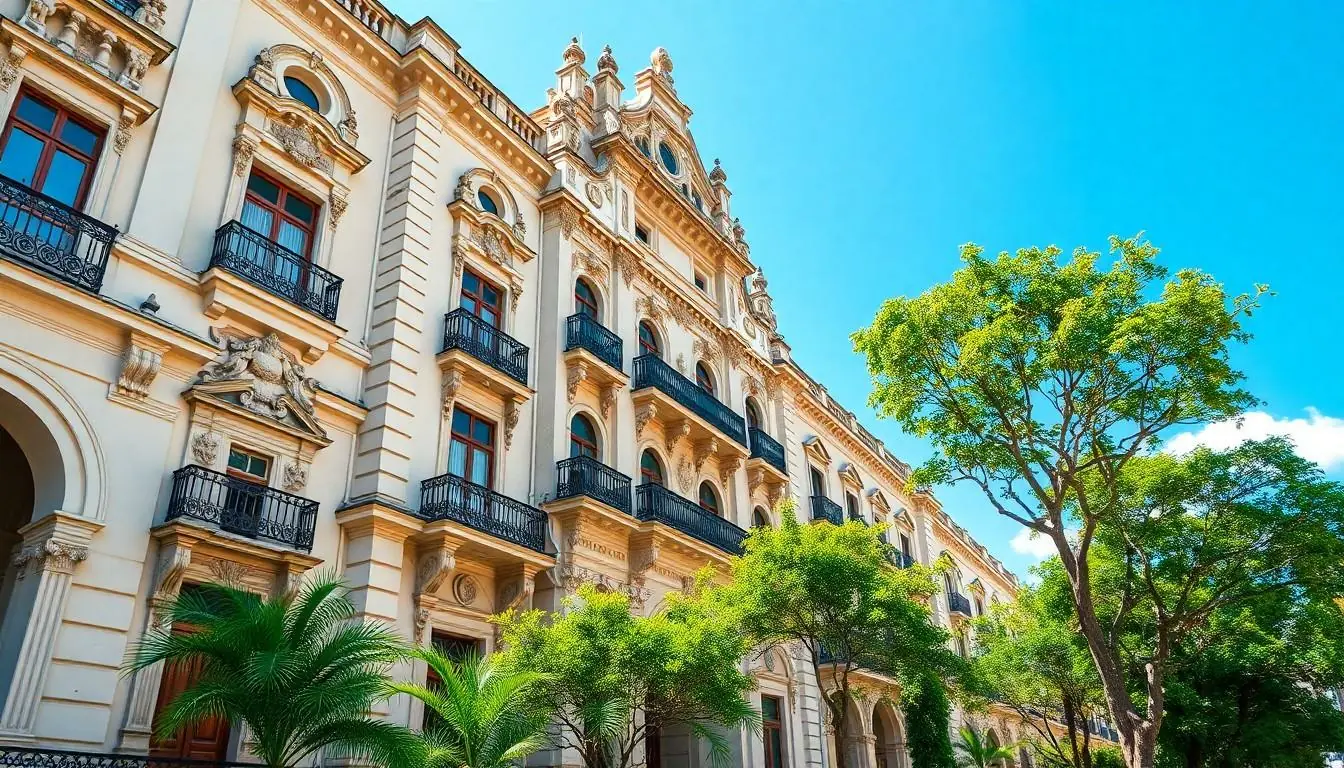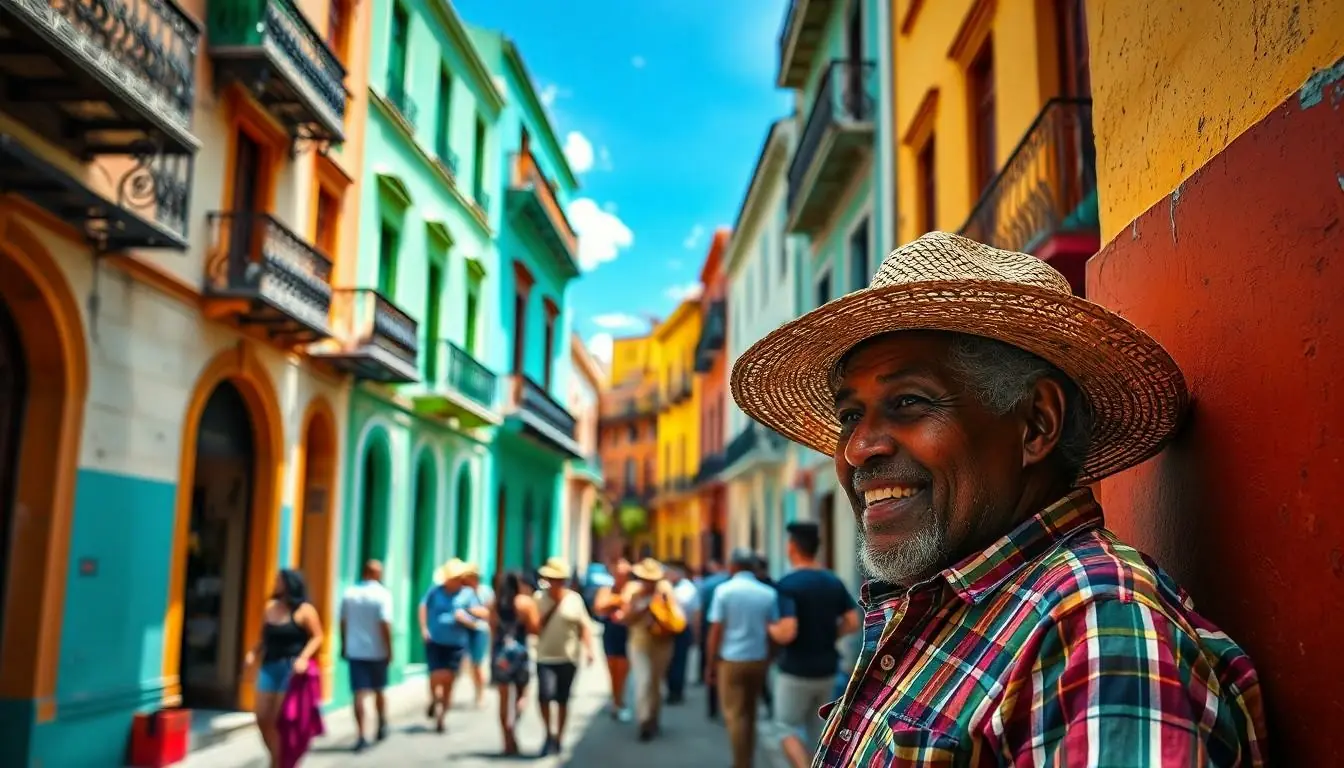Cuban architecture is like a vibrant salsa dance—full of rhythm, color, and a touch of nostalgia. With its eclectic blend of Spanish colonial, Art Deco, and modernist influences, the buildings tell stories that span centuries. From the grand facades of Havana to the charming streets of Trinidad, each structure invites you to explore its rich history and cultural significance.
Table of Contents
ToggleOverview of Cuban Architecture
Cuban architecture showcases a vibrant tapestry of styles that mirror its rich history and cultural significance. The fusion of various elements illustrates the island’s dynamic evolution over the centuries.
Historical Influences
Spanish colonial architecture laid the groundwork for Cuba’s distinct aesthetic. Structures from the 16th to 19th centuries display baroque and neoclassical influences. During the early 20th century, Art Deco emerged alongside modernist movements, reflecting global trends. Notable landmarks like the Capitolio in Havana exemplify this diverse architectural heritage. The mix of Caribbean and European styles creates a unique identity evident in many historical buildings.
Key Characteristics
Cuban architecture incorporates unique features that distinguish it from other regions. Bold colors and intricate wrought-iron details accentuate many facades. Large verandas often overlook vibrant streets, encouraging interaction. Many buildings exhibit high ceilings and expansive windows, maximizing airflow and light. The use of local materials such as coral stone and terra cotta further enhances authenticity. Architectural diversity contributes to the picturesque landscape, inviting exploration and appreciation of Cuba’s structural beauty.
Notable Architectural Styles

Cuban architecture features distinct styles that reflect the island’s rich heritage and cultural evolution. Each style tells a story, showcasing the diverse influences that shape Cuba’s built environment.
Colonial Architecture
Colonial architecture dominates Cuba’s historical landscape, showcasing designs from the 16th to the 19th centuries. Spanish colonial buildings often present baroque and neoclassical elements, particularly in cities like Havana and Santiago de Cuba. Well-known structures include the Cathedral of Havana, characterized by its intricate facades and grand courtyards. Additionally, thick walls made from local materials enhance durability, while ornamental details like balconies and wrought iron add charm. Classic features such as large arches and tiled roofs connect these buildings to their Spanish roots, creating a lasting visual appeal.
Art Deco and Modernism
In the early 20th century, Art Deco and modernism gained popularity in Cuba, significantly influencing its architectural landscape. The Capitolio in Havana stands as a prime example of this movement, blending classical elements with modern design. Geometric forms, vibrant colors, and decorative motifs define many buildings from this era. Noteworthy structures feature elaborately detailed facades with contrasting materials that enhance visual interest. Urban centers like Havana showcase a variety of Art Deco buildings, contributing to the city’s dynamic character. Icons of modernism also emerge through clean lines and functional designs that reflect evolving tastes and lifestyles.
Contemporary Trends
Contemporary trends in Cuban architecture reveal a focus on sustainability and innovation. Recent projects often incorporate eco-friendly materials and designs that embrace the island’s natural beauty. Bold designs merge traditional styles with modern aesthetics, creating a unique blend that respects history while pushing boundaries. Architects emphasize community engagement in their designs, fostering a sense of belonging and cultural identity. Adaptive reuse of historical buildings combines the old with the new, preserving cultural heritage while meeting contemporary needs. Urban developments increasingly emphasize green spaces, enhancing quality of life and promoting environmental responsibility.
Iconic Buildings and Structures
Cuban architecture features numerous iconic buildings and structures that define its urban landscape. Two notable examples reflect the island’s rich history and diverse architectural styles.
The Capitolio
The Capitolio stands as a monumental symbol of Havana’s grandeur. This neoclassical building, completed in 1929, mirrors the United States Capitol in Washington, D.C. A striking dome dominates the skyline, reaching 91 meters in height. Its intricate detailing showcases stunning marble interiors and grand staircases, revealing Havana’s architectural ambition during the early 20th century. Now functioning as the National Assembly, this structure represents Cuba’s commitment to preserving its historical and cultural heritage.
The Malecón
The Malecón stretches along Havana’s coastline, acting as both a scenic promenade and social hub. This iconic seawall spans 8 kilometers and provides stunning views of the Caribbean Sea. Vibrant art deco buildings line the promenade, creating a picturesque backdrop for leisurely strolls. Locals and tourists alike gather here to experience Cuba’s vibrant culture, making it a focal point for gatherings and celebrations. The Malecón embodies the spirit of the city, bridging the gap between architectural beauty and everyday life.
Preservation and Restoration Efforts
Preservation efforts in Cuban architecture aim to maintain and restore the island’s rich architectural heritage, facing significant challenges along the way.
Challenges Faced
Aging infrastructure poses a major hurdle. Many historic buildings suffer from decay due to insufficient maintenance and funding. Additionally, economic constraints limit resources for comprehensive restoration projects. Natural elements, such as hurricanes and humidity, exacerbate the deterioration of structures, especially those near the coast. Furthermore, bureaucratic hurdles often delay restoration efforts, as navigating permits and regulations can be complex. Communities may also struggle with prioritizing preservation over development, leading to potential loss of architectural significance.
Successful Projects
Notable restoration initiatives highlight the commitment to preserving Cuba’s architectural identity. The restoration of the Centro Histórico de La Habana, declared a UNESCO World Heritage site, showcases meticulous attention to detail and respect for original designs. In Trinidad, the restoration of the Casa de la Musica revitalizes historic buildings and promotes cultural activities. The renovation of the Museo Nacional de Bellas Artes has enhanced public access to artistic heritage while reinforcing architectural integrity. Collaborations between government entities and international organizations have facilitated the restoration of the iconic Capitolio, ensuring its prominence in Havana’s skyline remains intact.
Impact on Cuban Culture and Identity
Cuban architecture profoundly shapes the island’s cultural narrative and collective identity. It serves as a physical testament to Cuba’s diverse history, intertwining influences from various regions and epochs. The presence of Spanish colonial buildings in cities like Havana and Santiago de Cuba highlights enduring cultural connections to Spain, while modernist designs reflect responses to global architectural trends.
Traditions and daily life are woven into the designs of Cuban structures. Elements such as spacious verandas and high ceilings facilitate social interactions, underscoring the island’s communal ethos. Structures like the Cathedral of Havana exemplify spiritual significance, creating places where cultural and religious gatherings occur, fostering unity among the population.
Art Deco and modernist styles, prominent in early 20th-century architecture, also contribute to the modern Cuban identity. Buildings like the Capitolio not only symbolize political power but also demonstrate cultural aspirations and achievements. Citizens often take pride in these landmarks, viewing them as reflections of national resilience and creativity.
Preservation efforts play a crucial role in maintaining this architectural heritage. Restoration projects, such as those in the Centro Histórico de La Habana, actively engage local communities during the process to reinforce historical significance and cultural pride. Collaborative work between governmental and international organizations ensures that projects respect both the architectural integrity and the surrounding environment.
Cuban architecture acts as a narrative vessel, telling the stories of past struggles, triumphs, and ongoing evolution. Each structure contributes to a shared sense of place, fostering cultural pride and reinforcing the island’s unique identity in the global context.
Cuban architecture stands as a vibrant reflection of the island’s rich history and cultural identity. Its eclectic styles tell stories of resilience and innovation, inviting exploration and admiration. The blend of colonial, Art Deco, and modernist influences showcases not only aesthetic diversity but also the enduring spirit of the Cuban people.
As preservation efforts continue to evolve, the commitment to maintaining this architectural heritage remains crucial. Each structure holds significance, contributing to a collective narrative that shapes Cuba’s unique character. The ongoing journey of restoration and adaptation ensures that these buildings will continue to inspire future generations, celebrating the island’s past while embracing its dynamic future.



